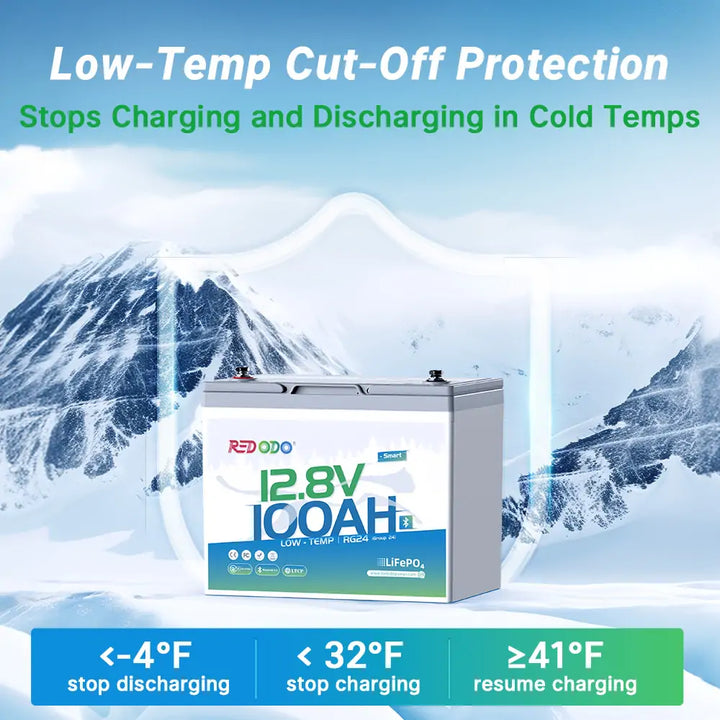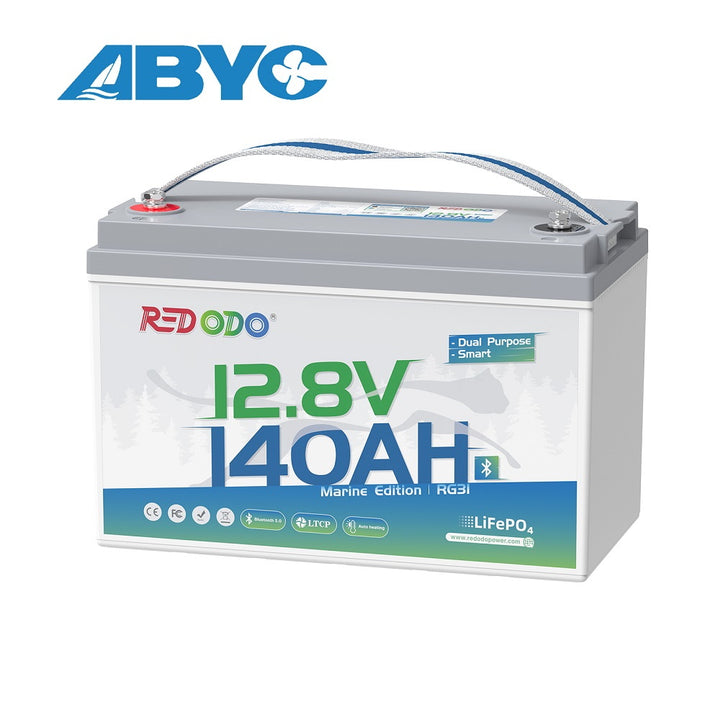12V batteries are among the most versatile and widely used options, from mobile device to RVs, boats, and car systems. This guide will explore what a 12V battery is, 12V batteries types, available sizes, applications, and essential tips for charging and maintaining them.
Table of Content
What is a 12V Battery?
A 12V battery is a rechargeable battery that made up of several cells connected in series, which deliver a stable and reliable energy output.
12V batteries are commonly used in vehicles, boats, RVs, and off-grid solar systems. These batteries are designed to provide steady power for extended periods, making them ideal for starting applications (like boat engines) or deep-cycle usage (such as powering appliances, home energy backup).
12V Battery Types
12 Volt batteries are available in different types. The common two types are Lead-Acid Batteries and Lithium-Ion Batteries.
12V Lead-acid Battery
Lead-acid batteries are the most traditional type of 12V battery, offering cost-effectiveness and reliability. They are made up of six 2-volt cells connected in series and used extensively in automotive, marine, and backup power systems.
1. Flooded Lead-Acid (FLD) Batteries
Flooded Lead-Acid batteries are the most basic form of lead-acid batteries. They use liquid electrolyte (sulfuric acid) to generate energy and require regular maintenance to replenish water levels.
Pros:
- Affordable and widely available.
- High starting power, suitable for vehicle engines.
Cons:
- Requires regular maintenance to monitor water levels and electrolyte health.
- Must be installed upright to prevent leaks.
- Sensitive to extreme temperatures, which can reduce performance and lifespan.
- Short lifespan of 2–3 years.
2. Gel Batteries
Gel batteries are a subtype of sealed lead-acid batteries. They use a gel-like electrolyte, making them spill-proof and more durable in harsh environments.
Pros:
- Maintenance-free and leak-proof, allowing versatile installation orientations.
- Durable and less prone to vibration damage.
Cons:
- Higher initial cost compared to FLD batteries.
- Sensitive to overcharging, which can damage the battery permanently.
- Less suitable for automotive use than AGM.
3. AGM (Absorbent Glass Mat) Batteries
AGM batteries are another sealed variant of lead-acid batteries. They use fiberglass mats to hold the electrolyte, offering better durability and efficiency.
Pros:
- Maintenance-free and spill-proof, offering greater convenience.
- Can handle moderate to high power demands.
Cons:
- More expensive than FLD and Gel batteries.
- Sensitive to overcharging and requires careful charging practices.
12V Lithium-Ion Batteries
A 12V lithium battery is formed by connecting three or four lithium cells in series, with the nominal voltage of 3.2 or 3.7 volts per cell. Their features are high performance, lightweight design, and long lifespans.
12V lithium-ion batteries (typically LiFePO4 batteries) are increasingly used in RVs, marine systems, and renewable energy setups, making them a good alternative to lead-acid batteries.
Lithium Iron Phosphate (LiFePO4) Batteries
LiFePO4 batteries are a subtype of lithium-ion batteries known for their safety, stability, and longevity. They are the most common choice of lithium battery for high-demand applications and energy storage.
Pros:
- Lightweight and compact, making them ideal for outdoor applications.
- Long lifespan of 4,000+ cycles, significantly longer than lead-acid batteries.
- High energy efficiency with rapid charging and consistent power output.
- Maintenance-free with built-in Battery Management Systems (BMS) for enhanced safety.
Cons:
- Higher upfront cost, although their longevity offsets this in the long term.
- Unable to be charged below freezing temperatures.
12V Battery Sizes
Battery sizes 12V depend on its capacity. Take an example of Redodo 12V LiFePO4 Batteries, which includes options from compact 50Ah models to powerful 400Ah batteries:
|
Model |
Capacity (Ah) |
Weight (lbs) |
Dimensions (inches) |
Ideal Applications |
|
50Ah |
11.66 |
7.68*6.54*6.77 |
Small appliances, backup power, RVs, trolling motors |
|
|
100Ah |
22.05 |
13*6.77*8.5 (Group 31) |
RVs, solar systems, trolling motors |
|
|
140Ah |
28.02 |
13*6.77*8.5 (Group 31) |
Middle-RVs, solar systems, trolling motors |
|
|
200Ah |
45.59 |
20.94*8.15*8.5 |
Off-grid systems, home storage, RVs |
|
|
300Ah |
59.88 |
20.55*9.33*8.58 |
Off-grid systems, home storage, RVs |
|
|
410Ah |
82.67 |
20.47*10.55*8.66 (Group 8D) |
Marine, large RVs, off-grid, home storage |
Key Takeaways on 12V Battery Sizes
- Compact Options (50Ah): Lightweight and portable, ideal for small electronics, RVs, kayaks, and short trips.
- Mid-Range Options (100Ah-200Ah): Versatile and suitable for RVs, boats, solar power, and moderate energy needs.
- High-Capacity Options (300Ah-400Ah): Designed for applications of high power demand, RVs, solar off-grid system, offering extended runtime and power.
Factors to Consider When Choosing a 12V Battery
Battery Purpose
The purpose of 12 volt battery you choose should align with your specific application.
Battery Capacity
The capacity (Ah) measures the amount of energy a battery can deliver over a specific time. A higher Ah rating indicates greater energy storage and longer runtime. For example, a 12V 200Ah battery can supply 10 amps for 20 hours or 20 amps for 10 hours.
Applications with high power demands, like RVs or off-grid systems, benefit from batteries with higher capacity. Ensure your battery’s output power matches the required demand of your devices.
Cold-Cranking Amps (CCA) for Starting Battery
Cold-cranking amps indicate the battery’s ability to start in cold temperatures, crucial for applications in freezing climates.
A higher CCA is essential for vehicles or boats operating in cold regions like Scandinavia, Canada, or Alaska. For example, our 800 CCA battery for boats is ideal choice in cold weathers and area.
Maintenance Requirements
For Flooded Lead-Acid Batteries, they require periodic water level checks and refilling with distilled water. Gel, AGM, and Lithium-Ion Batteries offer maintenance-free operation, making them ideal for users with limited time or technical expertise.
Cost
Cost is an essential consideration, but it’s important to balance price with quality and performance.
Lead-Acid Batteries, especially FLD batteries, are the more affordable option but with lower lifespan and higher maintenance needs. While lithium-ion batteries may have a higher upfront cost, their long-term value often outweighs cheaper alternatives, especially in demanding applications.
How to Charge a 12V Battery by Charger?
Charging a 12V battery correctly ensures its longevity. Simply follow these steps for charging your 12V battery:
- Select the Right Charger: Use a charger compatible with your battery type. For 12V LiFePO4 batteries, ensure to charge them by LiFePO4 battery chargers with 14.6V.
- Connect Charger Properly: Turn off the charger and ensure it is unplugged. Then, attach the positive cable (usually red) to the positive terminal (+) of the battery, and attach the negative cable (usually black) to the negative terminal (-).
- Complete the Charging: When the battery is fully charged, disconnect the charger first, then remove the negative cable and the positive cable. If the charger is equipped with Anderson terminals, you can disconnect the Anderson terminals directly after unplugging the charger's AC side. Avoid overcharging, as it can damage the battery, especially in lead-acid types without built-in protection.
Related Reading: Can I Charge LiFePO4 Battery with a Normal Charger?
Redodo 14.6V 20A Charger for 12V LiFePO4 Battery
Tips to Extend the Life of 12V Battery
- Charging properly: Use a compatible charger suited to your battery type. Avoid overcharging or undercharging to prevent damage.
- Avoid Deep Discharges: Avoid draining the battery below its recommended depth of discharge.
- Maintain Optimal Temperature: Operate and store the battery within its ideal temperature range to prevent performance degradation.
- Turn Off Electronics When Not in Use: Switch off lights, appliances, and other devices to avoid unnecessary battery drain.
- Check for Corrosion: For lead-acid batteries, inspect terminals for corrosion regularly. Clean them with a mixture of baking soda and water if buildup occurs. For 12V lithium batteries and lead-acid, check the terminals regularly to ensure they are in close contact.
- Check the Battery Regularly: Use a multimeter or consider batteries with Bluetooth to check the voltage and overall condition of the battery, especially haven't used it for a long time.
- Proper Long-term Storage: It is best to store your battery at a 50% charge level and recharge every three months if it is not going to be used for a long time. The ideal storage temperature is 10°C to 35°C / 50℉ to 95℉.
FAQs about 12 Volt Battery
How long does a 12V battery last?
The runtime of a 12V battery depends on its capacity and load power.
Run Time (hours) = Battery Capacity (Ah) / Current (A)
For example, a 12V 300Ah battery discharges at a rate of 20A could theoretically last about 15 hours. If discharging at 50A, it would only last approximately 6 hours.
Is a 12V deep cycle battery AGM?
Not all 12V deep cycle batteries are AGM (Absorbent Glass Mat). Deep cycle batteries come in various types, including flooded, gel, AGM, and lithium-ion (LiFePO4).
Are car batteries 12V? Why do cars use 12V batteries?
Yes, most modern cars use 12V batteries. The 12V system is standard because it provides enough power to start the engine and run electrical systems like lights, entertainment, and onboard computers. The 12V system is also compact, cost-effective, and widely available.
What does a 12V battery for boat weigh?
The weight of a 12V boat battery depends on the battery type and capacity. For a 12V 100Ah model, lead-acid batteries typically weigh between 40–70 lbs, while lithium-ion options can weigh significantly less, around 20–30 lbs, making them a preferred choice for lightweight setups.
Check out our lithium marine batteries to find the best options for you!
How long to charge a 12V battery at 10 amps?
The charging time for a 12V battery at 10 amps depends on its capacity and state of charge (SOC). For example, a 100Ah battery at 50% SOC would take approximately 5 hours to fully charge at 10 amps (50Ah ÷ 10A = 5 hours), and would take about 10 hours at 0% SOC. However, this estimate can vary based on charger efficiency and battery condition.
Read More:
Is a 12V 20Ah Lithium Battery Good for a Trolling Motor?
12V vs. 24V: Which RV Battery System is Better?

Redodo

Redodo
Recent Post

Convert RV from Lead-Acid to Lithium Battery: A Complete Guide

How Long Will a 200Ah Battery Run an Air Conditioner?

A Full Review of Redodo 12V 140Ah Group 31 Deep Cycle Battery

How Much Does it Cost to Replace Golf Cart Batteries?






![⚡[$239 after Sign-Up] Redodo 12V 100Ah Group 24 Bluetooth LiFePO4 Battery | Real-Time Battery Monitoring | For RV, Marine, Solar](http://www.redodopower.com/cdn/shop/files/Redodo_12V_100Ah_group_24_bluetooth_lithium_battery.jpg?v=1744253032)
![⚡[$220 after Sign-Up] Redodo 12V 100Ah Lithium Trolling Motor Battery With Low Temp Protection](http://www.redodopower.com/cdn/shop/files/Redodo12V100Ahlow-tempbattery.webp?v=1738462317)
![⚡[$220 after Sign-Up] Redodo 12V 100Ah Group 24 Deep Cycle LiFePO4 Lithium Battery | For Home, RV, Marine](http://www.redodopower.com/cdn/shop/files/Redodo_12V_100Ah_group_24_lithium_battery_6301965d-f6e8-467f-825f-3eec839b3e1f.jpg?v=1744105344)
![⚡[$239 after Sign-Up] Redodo 12V 100Ah Mini Bluetooth LiFePO4 Battery | For RV, Marine, Solar](http://www.redodopower.com/cdn/shop/files/12V100AhMiniSmartLiFePO4LithiumBatterywithBluetooth1.webp?v=1741251007)

![⚡[$294 after Sign-Up] Redodo 12V 140Ah Group 31 Lithium Battery with Bluetooth | 40% More Capacity | For RV, Marine, Solar Home](http://www.redodopower.com/cdn/shop/files/Redodo_12V_140ah_bluetooth_battery_ee6d5fd1-5c7d-4b9a-90ab-d54d06b29a04.jpg?v=1742967763)

![⚡[$377 after Sign-Up] Redodo 12V 200Ah Lithium LiFePO4 Battery | 1280W Load Power | For RV, Solar, Off-Grid](http://www.redodopower.com/cdn/shop/files/Redodo12V200ahlithiumbattery.jpg?v=1735892910)

![⚡[$524 after Sign-Up] Redodo 12V 300Ah Lithium LiFePO4 Battery | Replaces 6*12V 100Ah AGM Batteries | RV, Marine, Solar](http://www.redodopower.com/cdn/shop/files/Redodo_12V_300ah_lithium_deep_cycle_battery.png?v=1744797523)
![⚡[$947 after Sign-Up] Redodo 12V 410Ah Lithium LiFePO4 Battery | King of Power | Marine, RV, Solar Home](http://www.redodopower.com/cdn/shop/products/Redodo12V400Ahlithiumbattery-1.jpg?v=1736154087)
